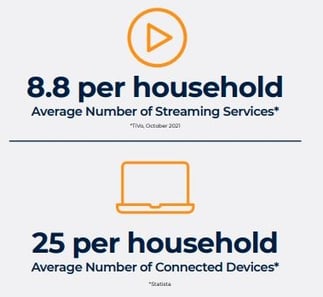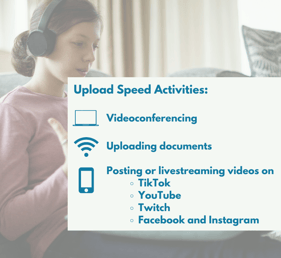
If your home has made the shift from in-office work to remote or hybrid setups, if you livestream regularly, or if gaming is part of your daily routine — then upload speed should be at the top of your list when choosing an internet plan.
Upload speed determines how fast you can send content to the internet. And as more people in your home go online to video chat, share content, or stream, those upload demands add up quickly.
Download vs. Upload Speeds: What’s the Difference?
Think of your internet like a two-way street. Both are important, but in today’s connected homes, upload speeds are becoming increasingly critical.
- Download speed is how fast you can receive data — like watching a Netflix show, scrolling social media, or reading an email.
- Upload speed is how fast you can send data — like sharing a TikTok, sending large files, or presenting on a video call.
Why should you care about upload speeds? 
Home internet usage has exploded over the past few years. According to the latest OpenVault Broadband Insights Report, the average U.S. household now has more than 25 connected devices and uses over 650 GB of data per month — and those numbers continue to rise every year.
That means your Wi-Fi isn’t just supporting your laptop anymore. It’s powering smart TVs, phones, tablets, cameras, gaming consoles, and virtual assistants — all competing for bandwidth.From livestreaming on Twitch and posting videos on YouTube to sharing content on Instagram and TikTok, upload-heavy activities are now part of everyday life.
Alone these activities may not seem like such a burden on your home network; however, the need for faster upload speed adds up when multiple people engage in similar activities at the same time on the same network.
How Much Upload Speed Do You Really Need?
 A single livestream in 1080p might require about 6 Mbps, but if you’re streaming in 4K or uploading to multiple platforms, you’ll need closer to 35–50 Mbps for a smooth, uninterrupted experience according to (HighSpeedInternet.com).
A single livestream in 1080p might require about 6 Mbps, but if you’re streaming in 4K or uploading to multiple platforms, you’ll need closer to 35–50 Mbps for a smooth, uninterrupted experience according to (HighSpeedInternet.com).
Now add a remote worker in the next room, a student on a virtual class, and a roommate gaming online — and your upload needs multiply fast.
That’s where fiber makes a real difference.
Fiber Internet: The Upload Advantage
Traditional cable internet typically offers upload speeds between 10–35 Mbps, which can quickly become a bottleneck for today’s connected homes.
altafiber’s fiber internet delivers symmetrical speeds — meaning upload speeds as fast as download speeds, ranging from 200 Mbps up to 1,000 Mbps. That means crystal-clear video calls, lag-free gaming, and lightning-fast file uploads, even with multiple devices online at once.
Cable internet connections, which do not use fiber all the way to the home, typically offer upload speeds from about 10 Mbps to 35 Mbps. altafiber currently offers upload speeds from 200 to 1,000 Mbps.
With increased reliance on the internet for everything from communication to work to entertainment, internet usage and bandwidth consumption will continue to grow exponentially.
altafiber has been hard at work investing in fiber infrastructure to increase our existing customer base's upload and download speeds. If you have a house or apartment full of remote workers, learners, gamers, or TikTokers, make sure your connection can keep up.
Check your fiber availability and explore altafiber’s high-speed bundles today.
